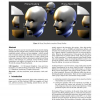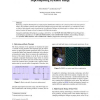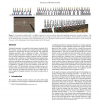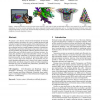61
Voted
TOG
2008
15 years 18 days ago
2008
Modern 3D engines used in real-time applications provide shading that hides the lack of higher order continuity inside the shapes using modulated normals, textures, and tone-mappi...
57
Voted
TOG
2008
15 years 18 days ago
2008
121
Voted
TOG
2008
15 years 18 days ago
2008
This paper presents a technique for acquiring the shape of realworld objects with complex isotropic and anisotropic reflectance. Our method estimates the local normal and tangent ...
100
click to vote
TOG
2008
15 years 18 days ago
2008
We present a video-based interface that allows users of all skill levels to quickly create cutout-style animations by performing the character motions. The puppeteer first creates...
83
Voted
TOG
2008
15 years 18 days ago
2008
Replacing a uniform illumination by a high-frequent illumination enhances the contrast of observed and captured images. We modulate spatially and temporally multiplexed (projected...
109
Voted
TOG
2008
15 years 18 days ago
2008
Simulated characters in simulated worlds require simulated skills. We develop control strategies that enable physically-simulated characters to dynamically navigate environments w...
94
Voted
TOG
2008
15 years 18 days ago
2008
We present a new discrete velocity-level formulation of frictional contact dynamics that reduces to a pair of coupled projections and introduce a simple fixed-point property of th...
92
Voted
TOG
2008
15 years 18 days ago
2008
We synchronize film cameras and LED lighting with off-the-shelf video projectors. Radiometric compensation allows displaying keying patterns and other spatial codes on arbitrary r...
TOG
2008
15 years 18 days ago
2008
In 3D renderings of complex scenes, objects of interest may be occluded by those of secondary importance. Cutaway renderings address this problem by omitting portions of secondary...
91
Voted
TOG
2008
15 years 18 days ago
2008
Character skinning determines how the shape of the surface geometry changes as a function of the pose of the underlying skeleton. In this paper we describe skinning templates, whi...




